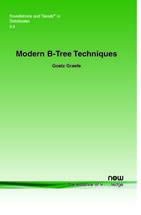Modern B-Tree Techniques
By Goetz Graefe, Hewlett-Packard Laboratories, USA, goetz.graefe@hp.com
Abstract
Invented about 40 years ago and called ubiquitous less than 10 years later, B-tree indexes have been used in a wide variety of computing systems from handheld devices to mainframes and server farms. Over the years, many techniques have been added to the basic design in order to improve efficiency or to add functionality. Examples include separation of updates to structure or contents, utility operations such as non-logged yet transactional index creation, and robust query processing such as graceful degradation during index-to-index navigation.
This survey reviews the basics of B-trees and of B-tree indexes in databases, transactional techniques and query processing techniques related to B-trees, B-tree utilities essential for database operations, and many optimizations and improvements. It is intended both as a survey and as a reference, enabling researchers to compare index innovations with advanced B-tree techniques and enabling professionals to select features, functions, and tradeoffs most appropriate for their data management challenges.
Modern B-Tree Techniques
Invented about 40 years ago and called ubiquitous less than 10 years later, B-tree indexes have been used in a wide variety of computing systems from handheld devices to mainframes and server farms. Over the years, many techniques have been added to the basic design in order to improve efficiency or to add functionality. Examples include separation of updates to structure or contents, utility operations such as non-logged yet transactional index creation, and robust query processing such as graceful degradation during index-to-index navigation.
Modern B-Tree Techniques reviews the basics of B-trees and of B-tree indexes in databases, transactional techniques and query processing techniques related to B-trees, B-tree utilities essential for database operations, and many optimizations and improvements. It is intended both as a tutorial and as a reference, enabling researchers to compare index innovations with advanced B-tree techniques and enabling professionals to select features, functions, and tradeoffs most appropriate for their data management challenges.
